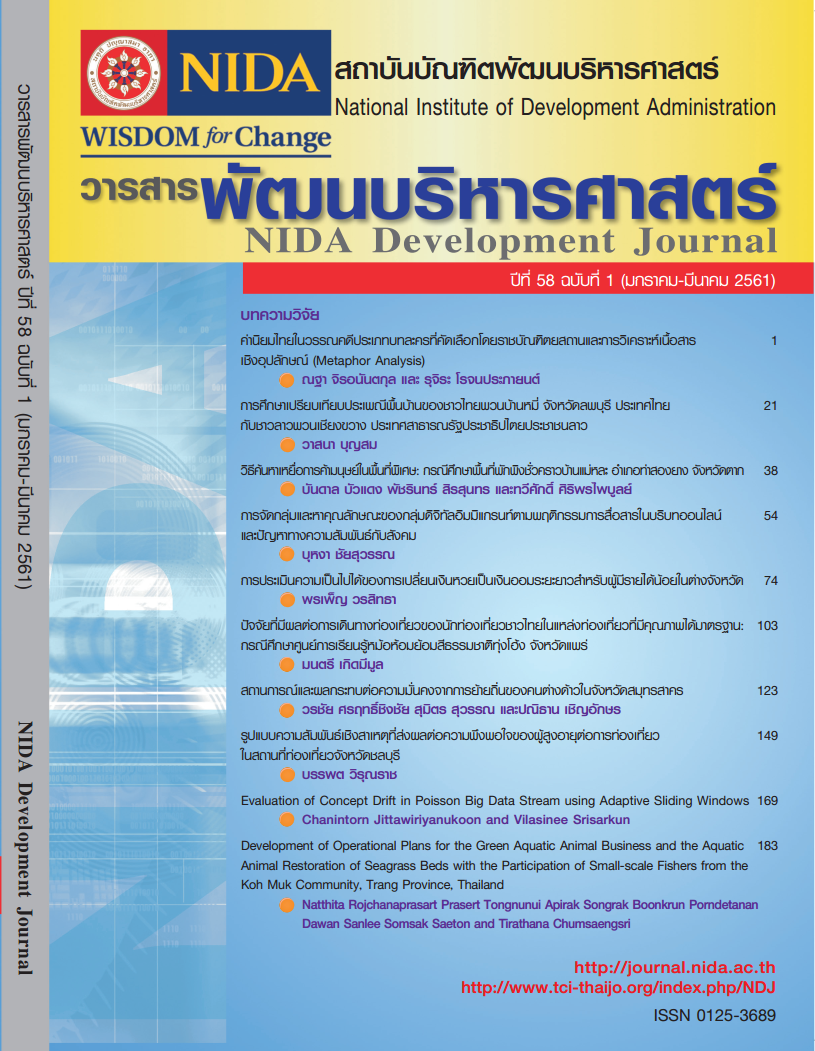A Causal Relationship Model Affecting the Aging’s Satisfaction with Tourist Attractions in Chonburi Province
Keywords:
Elderly Tourists, Satisfaction, Causal RelationshipAbstract
The objective of this research was to develop the causal relationship model affecting the elderly’s satisfaction with tourist attractions in Chonburi province. The study was a quantitative research and the questionnaire was used as tool for data collection. The participants were 240 Thai elderly tourists aged over 60 from 24 tourist attractions in Chonburi province. The hypothesis test was conducted to investigate the correlation between the developed causal relation model and empirical evidence by using the LISREL for the analysis of the Structural Equation Modeling (SEM).
The results revealed that Thai elderly tourists were satisfied with traveling to Chonburi’ s historical sites at the highest level. According to the hypothesis testing, the causal relationship model was correlated to the empirical evidence at high level. The satisfaction of Thai elderly tourists was related to three causal factors namely, 1. Marketing factors, 2. Management factors, and 3. Physical factors, arranged by priority order. In conclusion, the development of Chonburi’s tourist attractions required the cooperation between government sectors and every involved private sector to enhance the elderly’s preference for traveling to Chonburi.
References
Aroian, K. J., & Norris, A. E. (2001). Statistical methods for healthcare research (4th ed.). Philadelphia: Lippincott William & Wilkins.
Boksberger, P.E., Sund, K.J., & Schucker, M.R. (2009). Between Past, Present and Future-Implications of Socio-demographic Changes in. Trends and Issues in Global Tourism, 2009, 29-36.
Chen, S.C., & Shoemaker, S. (2014). Age and cohort effects: The American senior tourism market. Annals of Tourism Research, 48, 58-75.
Figueroa, M.J., Nielsen, T.S., & Siren, A. (2014). Comparing urban form correlations of the travel patterns of older and younger adults. Transport Policy, 35, 10-20.
Hair, J.F., Black, W.C., Babin, B.j., Anderson, R.E., & Tatham, R.L. (2006). Multivariate data analysis (6th ed.). Upper Saddle River, New Jersey: Prentice Hall.
Hair, J. F., Jr., Black, W. C., Babin, B. J., & Anderson, R. E. (2010). Multivariate data analysis: A global perspective (7th ed.). New Jersey: Pearson Prentice Hall.
Hu, L., & Bentler, P.M. (1999). Cutoff criteria for fit indices in covariance structure analysis: Conventional criteria versus new alternatives. Structural Equation Modeling, 6, 1-55.
Hjorthol, R.J., Levin, L., & Siren, A. (2010). Mobility in different generations of older persons
The development of daily travel in different cohorts in Denmark, Norway and Sweden. Journal of Transport Geography, 18, 624-633.
Jang, S.C., & Wu, C.E. (2006). Seniors’ travel motivation and the influential factors: Anexamination of Taiwanese seniors. Tourism Management, 27, 306-316.
Kotler, P., & Armstrong, G. (2001). Principles of marketing (9th ed.). New Jersey: Prentice Hall.
Kotler, P., & Armstrong, G. (2010). Principles of marketing (13th ed.). New Jersey: Pearson Education.
Rajaratnam, S.D., Munikrishnan, U.T., Sharif, S.P., & Nair, V.(2014). Service quality and previous
experience as a moderator in determining tourists’ satisfaction with rural tourism destinations
in Malaysia: A partial least squares approach. Procedia-Social and Behavioral Sciences,
144, 203-211.
Serre, D. L. & Chevalier, C. (2012). Marketing travel services to senior consumers. Journal of
Consumer Marketing, 29(4), 262-270.
Sukimon, M. F., Omar, S.I., Muhibudin, M., Yussof, I., & Mohamed, B. (2013). Tourist Satisfaction as
the key to Destination Surrival in Pahang. Procedia-Social and Behavioral Sciences, 91, 78-87.
Wang, B., Shao, C., Li, J., Weng, J., & Ji, X. (2015). Holiday travel behavior analysis and empirical study under integrated multimodal travel information service. Transport Policy, 39, 21-36.
Wang, K., Ma, A.,Hsu, M.Jao, P., & Lin, C. (2013). Seniors’ perceptions of service features on
outbound group package tours. Journal of Business Research, 66, 1021-1027.
Zheng, Z., Baohua, M., Mingjun, L., Jinchuan, C., & Jifu, G. (2007). Analysis of Travel Characteristics
of Elders in Beijing. Journal of transportation systems engineering and information technology, 7(6), 11-20.
Bureau of Empowerment for older Persons. (2015). Population Aging in Thailand, 2014. Retrieved April 3,
2015 from, https://www.oppo.opp.go.th/info/Aged%20IPSR%2010-1-57.pdf (in Thai).
Kongprasert, T., Passakonjaras, S., & Katawandee, P. (2014). Factors Influencing Type of Japanese Tourists
in Chiang Mai. Journal of Management Sciences, 31(2), 1-33. (in Thai).
National Statistical Office. (2014). Everyone Likes Travelling Thailand. Retrieved October 30, 2014,
from https://service.nso.go.th/nso/nsopublish/citizen/news/news_travel.jsp (in Thai).
Nida Poll. (2014). The Provinces in Thailand that Thai people want to go. Retrieved October 30, 2014,
from https://nidapoll.nida.ac.th/multimedia/Myfiles/Poll%202555/94/NIDA%20Poll_94.pdf.
(in Thai).
Tiansirir, J., Wandee, C., Boonyanupong, S., & Sungkakorn, K. (2012). Slow Tourism Market Potential
Evaluation for Elderly Tourists in Upper-North Region of Thailand. FEU Academic Review,
6(1), 49-62. (in Thai).
Wattanasaovaluk, K. (2014). Demographic Change: The Effects on The Wellbeing of Thai People.
Nida Development Journal, 54(1), 143-170. (in Thai).





